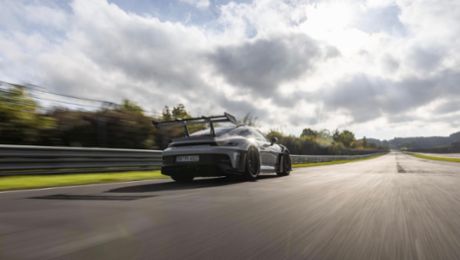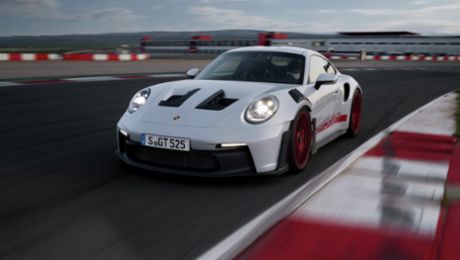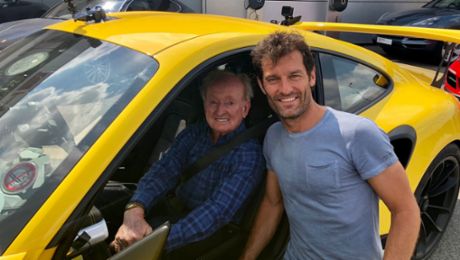This RS wants to be and do more. It is not just a sharper version of the already powerful 911 GT3. No, it is intended to poach in the preserve of the super sports cars, as you can see by just looking at it. As it stands on the road, it looks even wider, even more massive. “We have a tire width at the front that other sports cars would be proud to have at the rear,” says GT project manager Andreas Preuninger.
The front end, which is 5 centimeters wider than its predecessor, rolls on 265-millimeter-wide 20-inch tires. At the rear, the RS has grown by 3 centimeters compared to the conventional GT3 to allow the 325-millimeter-wide 21-inch tires to fit under the fender, as on the 918 Spyder.
“There’s so much power in that engine!”
“The only thing missing is racing tires,” says Sven Müller, who has come to Weissach with his racing colleague Earl Bamber to take a closer look at the GT3 RS. And he adds: “That’s a real monster.” A fitting description. Usually there are sports cars on one side and race cars on the other. But sometimes extreme creatures emerge from the motorsport department of the development center that blur the boundaries between the two.
Müller starts gushing: “There’s so much power in that engine!” There is a newly developed four-liter boxer engine under the rear lid. A longer stroke, shorter connecting rods, a crankshaft made of high-purity steel previously found only in aviation or Formula One. This allows the engine to get up to 8,800 rpm easily.
Reduced fuel consumption
The aspirator has a new air intake system and, like the 911 Turbo, “breathes” through lateral air intakes that pump air that has been compressed by 25 to 30 millibars into its “lungs” using the ram air effect. The new engine delivers 368 kW (500 hp, Combined fuel consumption 12.7 l/100 km; CO₂ emissions: 296 g/km), which is 37 kW (50 hp) more than its predecessor, while also reducing fuel consumption.
“We have outperformed ourselves when it comes to efficiency,” says project manager Preuninger. That applies to the aerodynamics as much as the engine. Sven Müller runs a hand over the rear wing. At 300 km/h, the new RS generates an overall downforce of 330 kilograms without producing problem zones of air resistance. A detail on the front end of the vehicle is partly responsible for this. “Do you see the ribbed air outlets on the carbon-fiber fenders? You usually find that only on pure sports cars,” says Earl Bamber.
A track app measures lap times with GPS
His enthusiasm grows when his colleague Müller shows him the standard cockpit encased in a rollover cage. “Look, there’s even a speed limiter for the pit lane,” says the German, pointing to a switch in the center console. The RS is usually the second Porsche in a customer’s garage and is a pure driving machine, often found on the racetrack. “Oh, it has a USB port,” praises Bamber. As one would expect in this digital age, Porsche also offers a track app that measures lap times with GPS.
For ambitious drivers, the newly programmed control unit also stores real racing parameters such as rpm, lateral acceleration, and brake pressure. On the iPad, fast laps can be laid over one another virtually, allowing the GT3 RS to follow itself around the track as a ghost car. Its predecessor will only be able to see the new RS as a speck on Döttinger Höhe at the end of its lap around the North Loop of the Nürburgring. The developers estimate the new one to be at least ten seconds faster.
Roof is made of magnesium sheet metal
Sven Müller knocks against the carbon front hood. As you would expect, the RS had to lose weight to become a real racing machine. An exhaust system made of titanium saves around four kilograms and, on the racetrack, the battery can be swapped for a lighter lithium-ion rechargeable battery. The real trick, however, is the striking roof with the wide groove in the middle, which reduces the frontal area. “The roof is an innovation not previously found in this form among automobiles. It is made of magnesium sheet metal and weighs one kilo less than a carbon-fiber roof,” says Preuninger.
The technical upgrade should have made the new RS significantly heavier than the conventional GT3: the increased dimensions of the chassis and the larger wheels alone account for 20 kilos of extra weight. The same applies to the dual-clutch transmission, which replaces the conventional gearbox. But the idea that fast lap times can be achieved only with extremely lightweight construction is no longer true.
Production until spring 2016
“If we have systems that improve performance and fit the vehicle, we put them in,” says Preuninger. And so the new GT3 RS is only ten kilos lighter than the previous one, because the engineers did not wish to forgo a torque vectoring differential and rear-axle steering, both of which improve handling and speed on curves.
“Unfortunately, even as a new factory driver for 2015, I won’t be given a GT3 RS as a company car,” sighs Bamber. The RS is not limited, but until the production window closes in Spring 2016, a maximum of two thousand units will find their way to happy new owners.
Porsche 911 GT3 RS (Type 991)
Engine: Six-cylinder boxer
Displacement: 3,996 cc
Power: 368 kW (500 hp; Combined fuel consumption 12.7 l/100 km; CO₂ emissions: 296 g/km)
Maximum torque: 460 Nm at 6,250 rpm
0–100 km/h: 3.3 sec.
Top track speed: 310 km/h (193 mph)
Info
Text first published in the Porsche customer magazine Christophorus, No. 371
By Markus Stier // Photos by Victor Jon Goico
Consumption data
911 GT3: Combined fuel consumption: 12,4 l/100 km; CO₂ emissions: 289 g/km
911 GT3 RS: Combined fuel consumption 12.7 l/100 km; CO₂ emissions: 296 g/km
911 Turbo: Combined fuel consumption: 9,7 l/100 km; CO₂ emissions: 227 g/km
918 Spyder: Combined fuel consumption: 3,1 – 3,0 l/100 km; CO₂ emissions: 72-70 g/km; Electricity consumption 12.7 kWh/100 km




